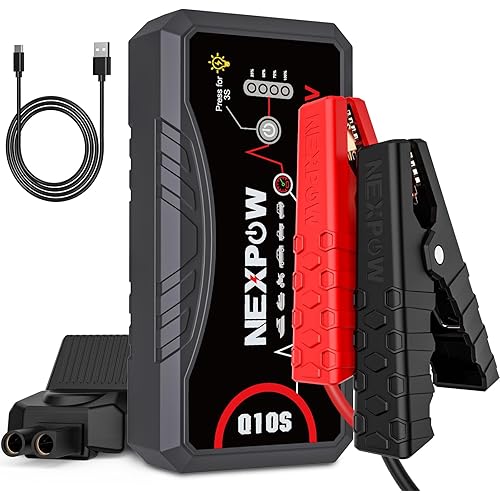Schumacher Electric Ship ‘n Shore 15A Car Battery Charger and Maintainer, 4-in-1 Solution, Battery Tester, for 6V/12V Power Sport, Automotive, and Marine Batteries, SC1360









Buy Now, Pay Later
- – 6-month term
- – No impact on credit
- – Instant approval decision
- – Secure and straightforward checkout
Ready to go? Add this product to your cart and select a plan during checkout.
Payment plans are offered through our trusted finance partners Klarna, Affirm, Afterpay, Apple Pay, and PayTomorrow. No-credit-needed leasing options through Acima may also be available at checkout.
Learn more about financing & leasing here.
Selected Option
FREE 30-day refund/replacement
To qualify for a full refund, items must be returned in their original, unused condition. If an item is returned in a used, damaged, or materially different state, you may be granted a partial refund.
To initiate a return, please visit our Returns Center.
View our full returns policy here.
Style: Without Start/Stop Button
Features
- Rapid Battery Charging: The Schumacher Electric SC1360 Rapid Battery Charger and Maintainer delivers 15-amp (12-volt) rapid charge, 2-amp (6-volt) charge, and 3-amp maintain modes
- Fully Automatic: Controlled by an internal microprocessor, the SC1360 features multi-stage charging, bad battery detection, float mode monitoring, and reverse hook-up protection
- Advanced Charging Algorithm: Schumacher Electrics multi-stage charging feature employs an advanced algorithm to maximize battery charge, health, and lifespan
- Float-Mode Monitoring: While in float mode, the SC1360 battery charger and maintainer delivers a small current when necessary to keep the unit fully charged
- Maintain Stored Batteries: Keep stored or infrequently used batteries fully charged and in top condition with the Schumacher Electric SC1360 battery charger and maintainer
- Works with Common Battery Types: The Schumacher Electric SC1360 charger is compatible with 6-volt and 12-volt standard, AGM, gel, and deep-cycle batteries
- In the Box: With your purchase, you will receive the Schumacher Electric Ship n Shore SC1360 15-Amp 6-Volt/12-Volt Fully Automatic Battery Charger and Maintainer and user manual
Description
Mechanics, both DIYers and professionals, trust Schumacher Electric’s extensive line of battery chargers and maintainers to keep their automotive, power sports, motorcycle, and marine batteries in top condition. Schumacher’s Ship ‘n Shore items offer the same quality, designed with marine batteries in mind. With 15-amp (12-volt) rapid charge, 2-amp (6-volt) charge, and 3A maintain modes, the Schumacher Electric Ship ‘n Shore SC1360 15-Amp 6-Volt/12-Volt Fully Automatic Battery Charger and Maintainer charges batteries quickly before automatically shifting to maintain mode to keep them fully charged, improve their battery health, and extend their lifespan. Fully automatic and microprocessor controlled, the Schumacher SC1360 employs multi- stage charging, bad battery detection, float mode monitoring, and reverse hook up protection. The unit is compatible with 6-volt and 12-volt standard, AGM, gel, and deep-cycle batteries. Other features include a digital display, LED indicators, push-button controls, wrap cleats for cord storage, 76-inch booster cables, and color-coded clamps. En español (ES): Los mecánicos, tanto aficionados como profesionales, confían en la amplia gama de cargadores y mantenedores de baterías de Schumacher Electric para preservar las baterías de automóviles, vehículos deportivos, motocicletas y embarcaciones en perfecto estado. Con modos de carga rápida de 15 amperios (12 voltios), carga de 2 amperios (6 voltios) y mantenimiento de 3 amperios, el cargador y mantenedor de baterías totalmente automático Schumacher Electric SC1360 de 15 amperios y 6 voltios/12 voltios carga las baterías rápidamente antes de cambiar de manera automática al modo de mantenimiento para preservar su carga máxima, mejorar su estado y prolongar su vida útil. Totalmente automático y controlado por un microprocesador, el modelo SC1360 de Schumacher emplea carga multietapa, detección de baterías defectuosas, monitoreo del modo de flotación y protección contra conexión inversa. La unidad es compatible con baterías estándares, AGM, de gel y de ciclo profundo de 6 V y 12 V. Otras características incluyen una pantalla digital, indicadores LED, botones de control, ganchos para enrollar el cable, cables de refuerzo de 76 pulgadas y pinzas codificadas por colores.
Brand: Schumacher Electric
Color: Blue
Product Dimensions: 9.8"D x 9.8"W x 3.8"H
Item Weight: 2.24 Pounds
Output Voltage: 12 Volts
Manufacturer: Schumacher Electric
Brand: Schumacher Electric
Model: SC1360
Item Weight: 2.24 pounds
Product Dimensions: 9.8 x 9.8 x 3.8 inches
Item model number: SC1360
Exterior: Machined
Manufacturer Part Number: SC1360
Date First Available: December 14, 2017
Frequently asked questions
To initiate a return, please visit our Returns Center.
View our full returns policy here.
- Klarna Financing
- Affirm Pay in 4
- Affirm Financing
- Afterpay Financing
- PayTomorrow Financing
- Financing through Apple Pay
Learn more about financing & leasing here.


















